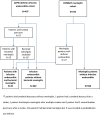Combined Bacterial Meningitis and Infective Endocarditis: When Should We Search for the Other When Either One is Diagnosed?
- PMID: 35618954
- PMCID: PMC9334461
- DOI: 10.1007/s40121-022-00651-7
Combined Bacterial Meningitis and Infective Endocarditis: When Should We Search for the Other When Either One is Diagnosed?
Abstract
Introduction: We aimed to describe patients with coexisting infective endocarditis (IE) and bacterial meningitis (BM).
Methods: We merged two large prospective cohorts, an IE cohort and a BM cohort, with only cases of definite IE and community-acquired meningitis. We compared patients who had IE and BM concurrently to patients with IE only and BM only.
Results: Among the 1030 included patients, we identified 42 patients with IE-BM (4.1%). Baseline characteristics of patients with IE-BM were mostly similar to those of patients with IE, but meningitis was the predominant presentation at admission (39/42, 92.3%). Causative pathogens were predominantly Streptococcus pneumoniae (18/42, 42.9%) and Staphylococcus aureus (14/42, 33.3%). All pneumococcal IE were associated with BM (18/18). BM due to oral and group D streptococci, Streptococcus agalactiae, and S. aureus were frequently associated with IE (14/30, 46.7%). Three-month mortality was 28.6% in patients with IE-BM, 20.5% in patients with IE, and 16.6% in patients with BM.
Conclusions: Patients with pneumococcal IE or altered mental status during IE must be investigated for BM. Patients with S. aureus, oral and group D streptococcal or enterococcal BM, or unfavorable outcome in pneumococcal meningitis would benefit from an echocardiography. Patients with the dual infection have the worst prognosis. Their identification is mandatory to initiate appropriate treatment.
Keywords: Austrian syndrome; Bacterial meningitis; Echocardiography; Infective endocarditis; Staphylococcus; Streptococcus.
© 2022. The Author(s).
References
LinkOut - more resources
Full Text Sources
Medical


